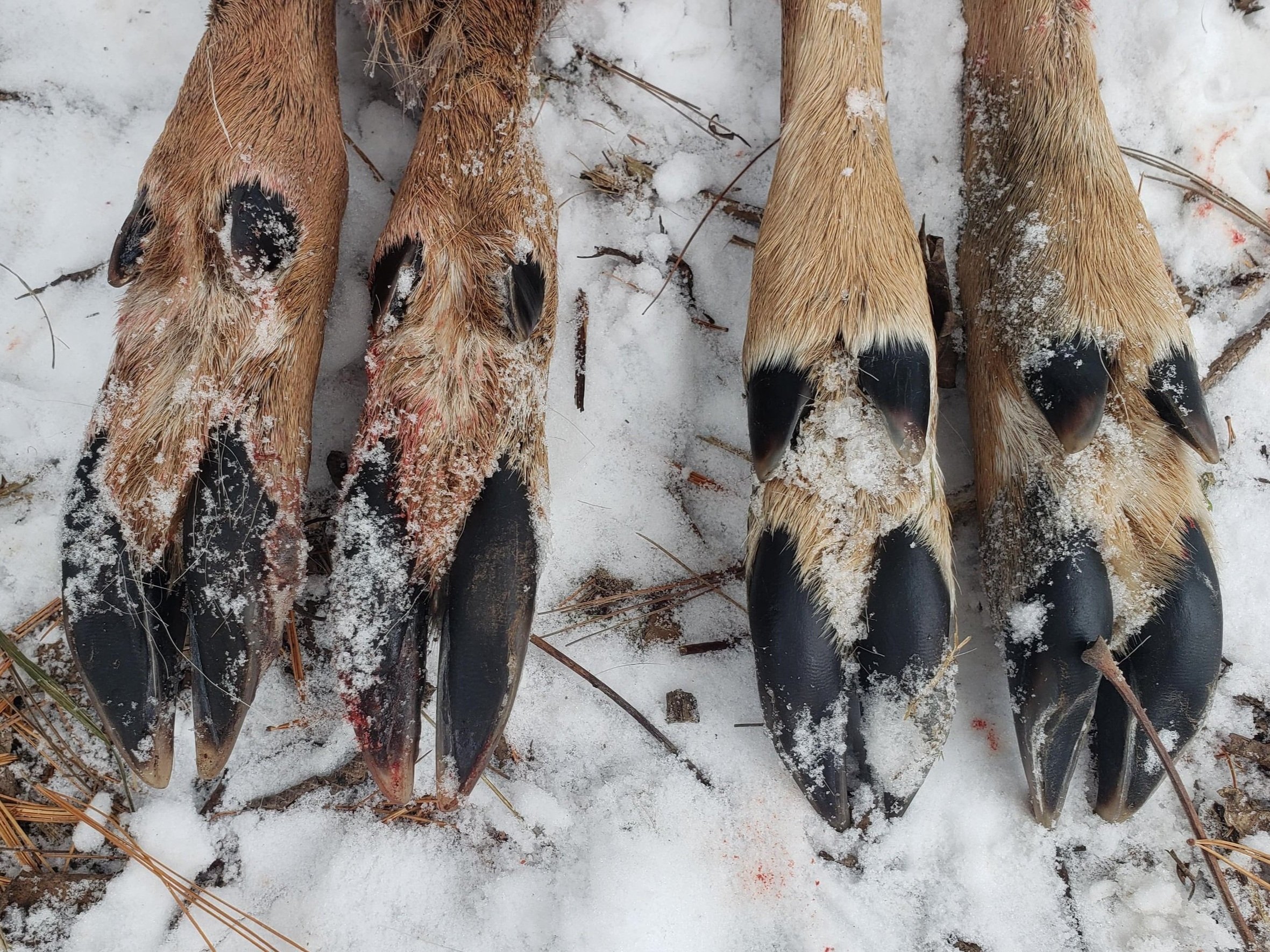What The Toes Show - A question of deer hooves
For the past four years there has been a bit of a conundrum at the tracking apprenticeship. There has been a theory passed around to be argued and analyzed, challenged and sustained. It has confronted, confused, and confounded many of us who have tried to scry a little more understanding from a couple of seemingly basic teachings, all from the hooves of White-tailed Deer (Odocoileus virginiana).
Image of ungulate foot from Mark Elbroch’s Mammal Tracks and Sign, 1st edition. Note that we are looking at the underside of the foot.
Let’s get started by looking at some deer feet, as a better understanding of the foot structure will help as we go.
Deer, like all mammals, have a shared ancestral line going back to a source animal who had five digits on each foot. Some mammals have lost one or all toes, some have reduced in size, some have changed location on the boney structure that makes up the hand. Today, these toes are counted from the inside out, 1 to 5, beginning with toe 1, which are our thumbs, and 5 being the pinky. Deer have four toes all of which can be seen and counted on the image to the right. Again, toe 1, analogous to our thumb, is gone entirely, lost to evolution and specialization. For deer, toes 2 and 5, equivalent to our pointer and pinky, are called “dewclaws” and they reside further up the hand from toes 3 and 4. When the deer walks they walk on toe 3 and 4, but in some substrates, such as deeper snow or mud, the dewclaws, toes 2 and 5, can be seen in the tracks.
As with all things in the world, we can go deeper and deeper into the anatomy of the hooves of deer, but I want to get to the point of the research. The main questions I have are :
1) Can you tell front or hind (hinds are sometimes referred to as rears in this post) foot in a track based on the location of the dewclaws?
2) Do front or hind dewclaws reside in the same position on the foot or are they more laterally located on the leg depending on which leg it is we are examining?
3) Can you tell left or right foot from the length of the toes?
These three questions are useful when tracking. The information would be useful to know when attempting to identify partial or individual tracks when more details are missing.
Hind feet on the left and front feet on the right of White-tailed Deer (Odocoileus virginianus)
Recently on a zoom call Alexis reiterated that in his experience the dewclaws, toes 2 and 5, on the front feet of the deer will be closer to toes 3 and 4, and on the back feet, dewclaws will be set further back. He backed up this claim by showing the image above. Alexis had butchered the deer whom these feet came from and he knew which legs were which. This is helpful because sometimes the legs can get mixed up. In the image the hind hooves are on the left side, and the front hooves on the right. When it was noted that the rear hooves look longer than the fronts, Alexis agreed and made the plan to measure them later. Here are his measurements :
Front Foot - 7.62 x 3.97 cm (3" x 1 9/16" in)
Rear Foot - 7.3 x 3.81 cm (2 7/8" x 1 1/2" in)
From looking at this image it would appear that the dewclaws are set further back on the hinds, and are closer to the front on the fronts. This appeared to confirm what I understood to be true as well. This also upholds my mnemonic on the topic, “back is back”, implying that the dewclaws on the back feet are also set further back from toes 3 and 4.
A great thing about a prolonged problem where for multiple years we as tracking apprentices have been trying to work together to figure something out is that many people will be approaching the same problem. Another multiple year apprentice Alastair had also been researching this same issue on his own accord, having asked a neighbour if he could have the legs from any deer the neighbour had hunted that season. Alastair then compared the legs and offered his findings over the Zoom call.
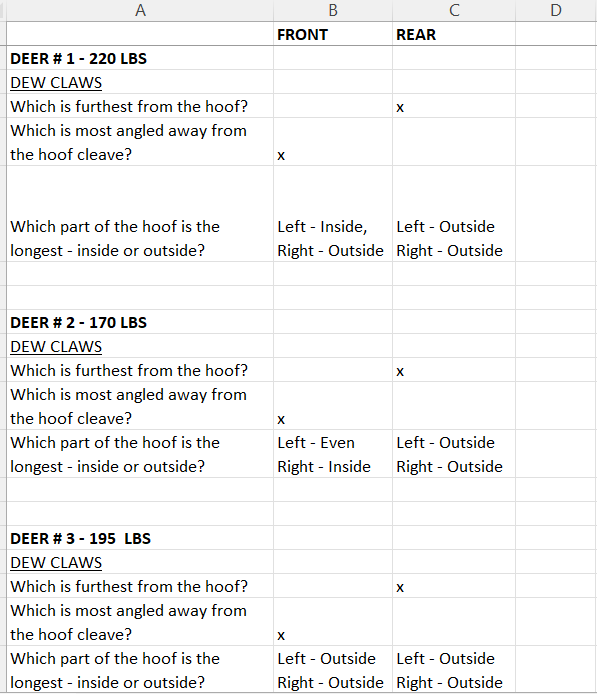
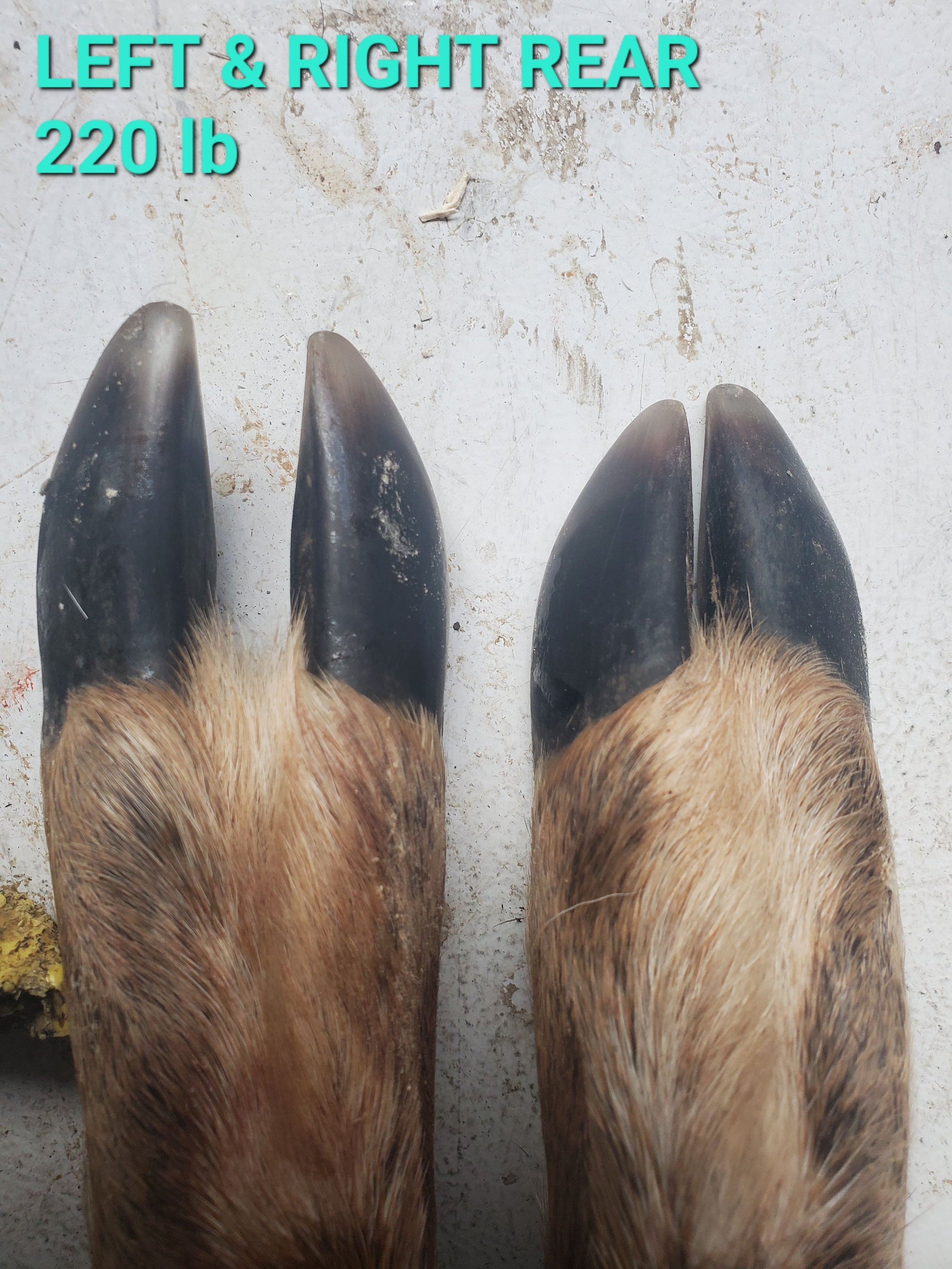
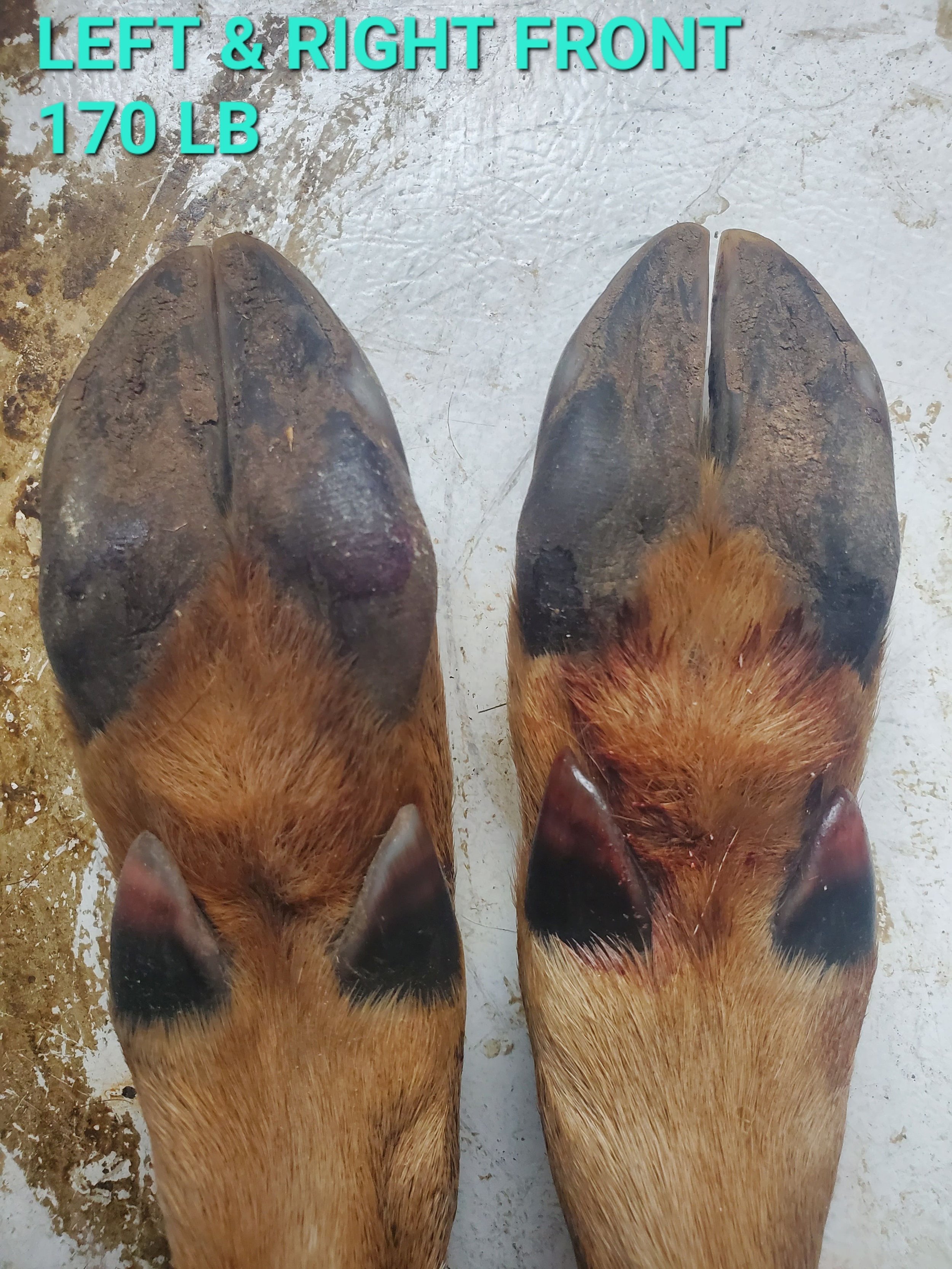
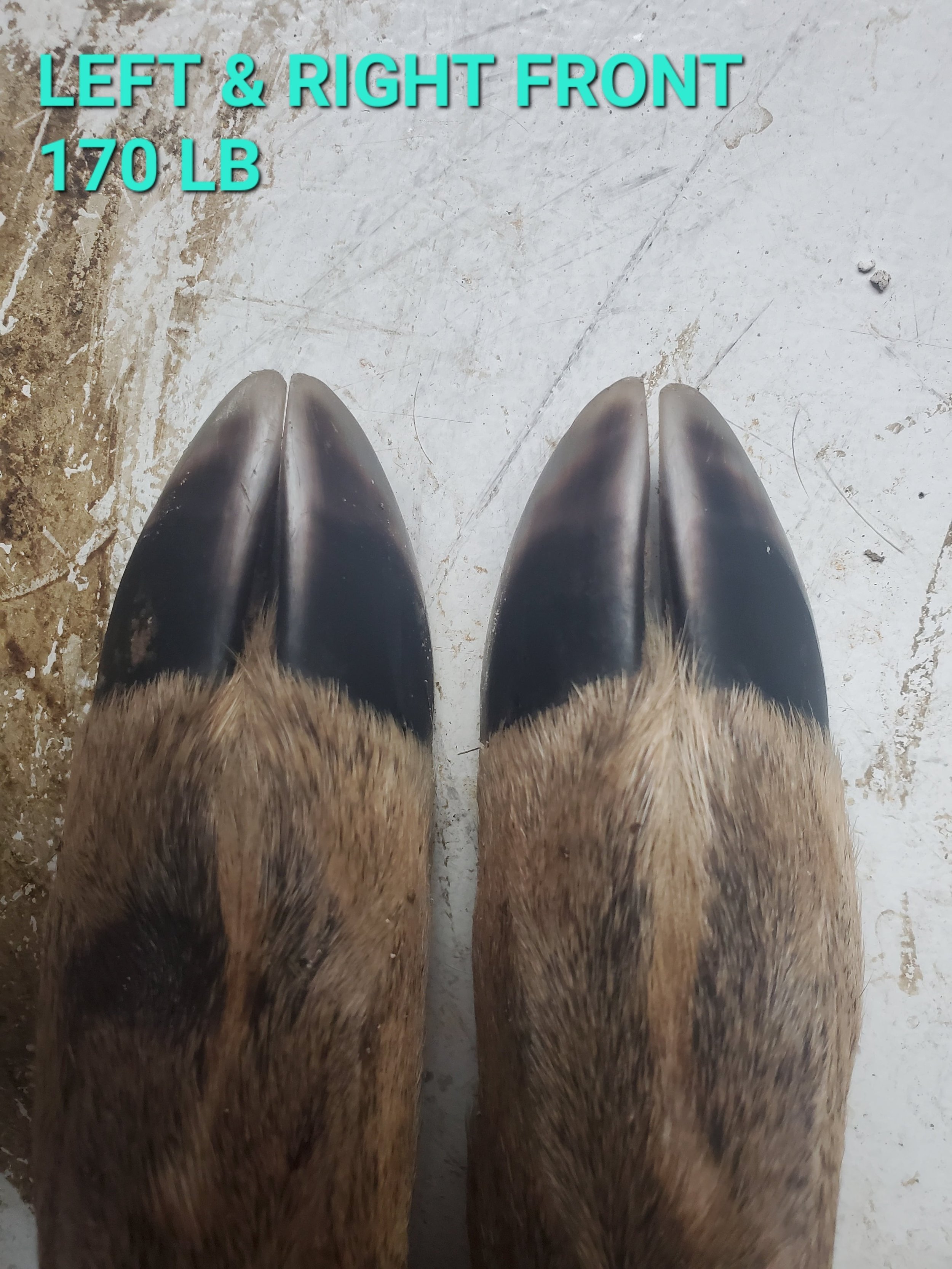
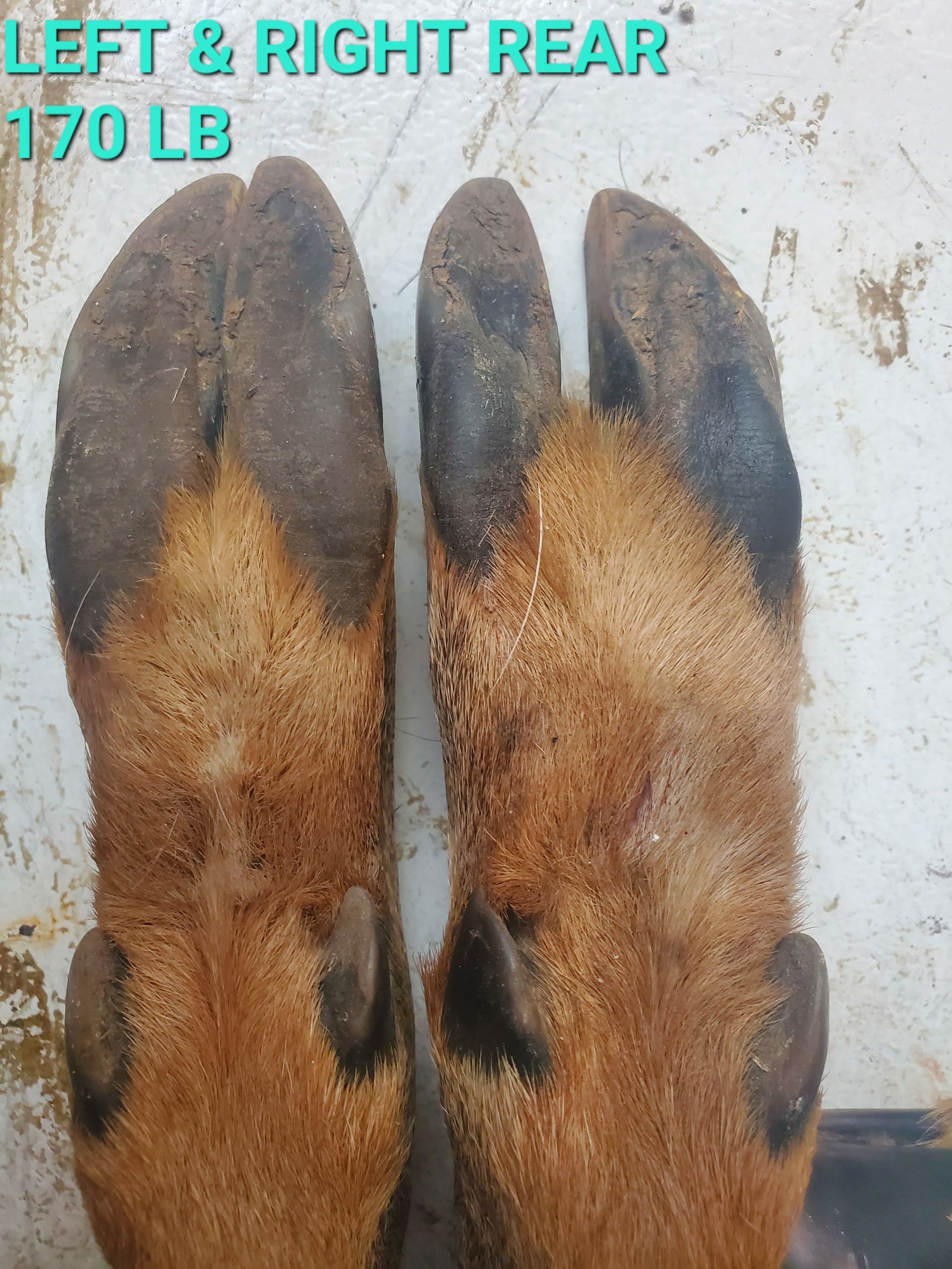
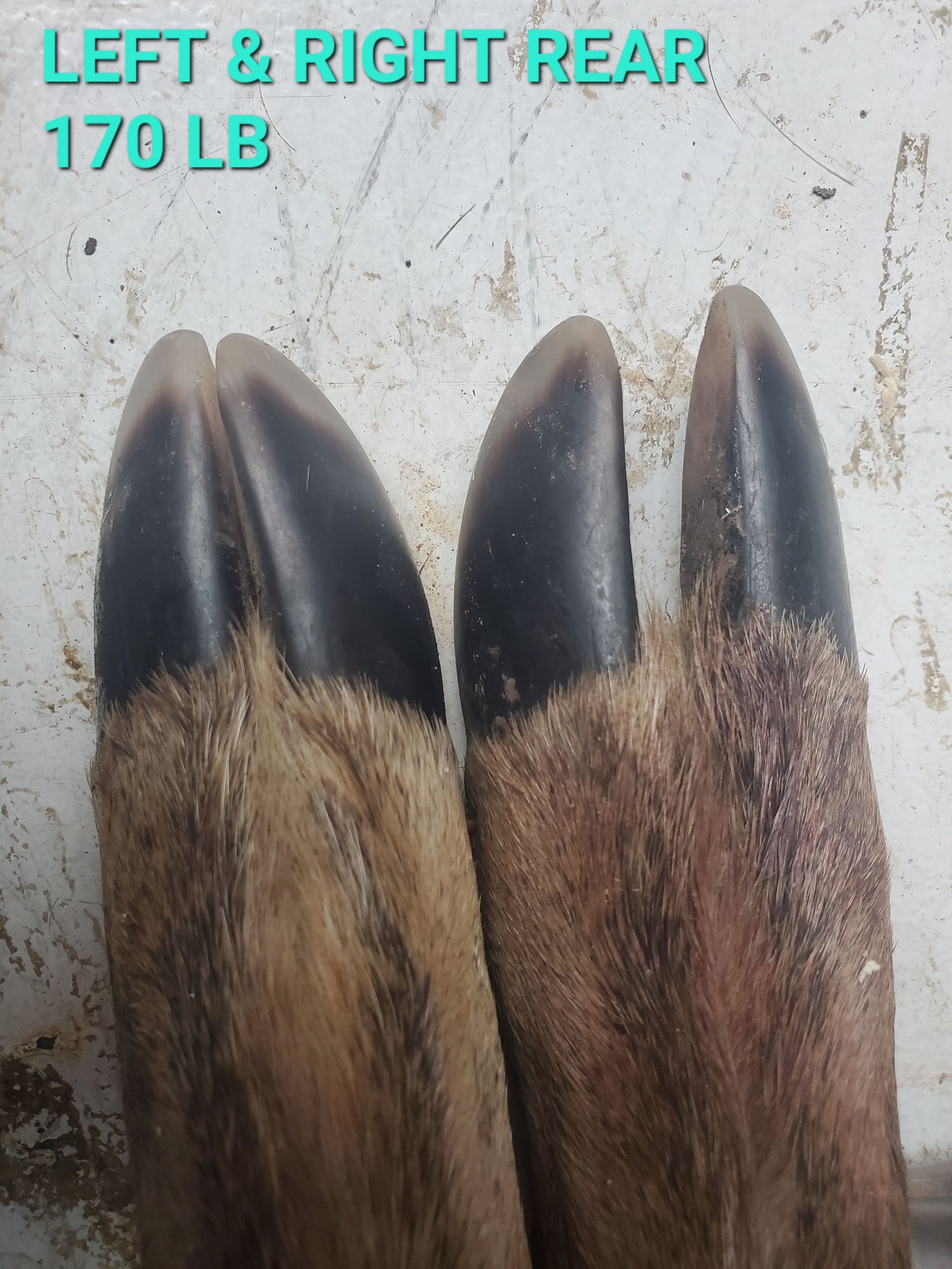
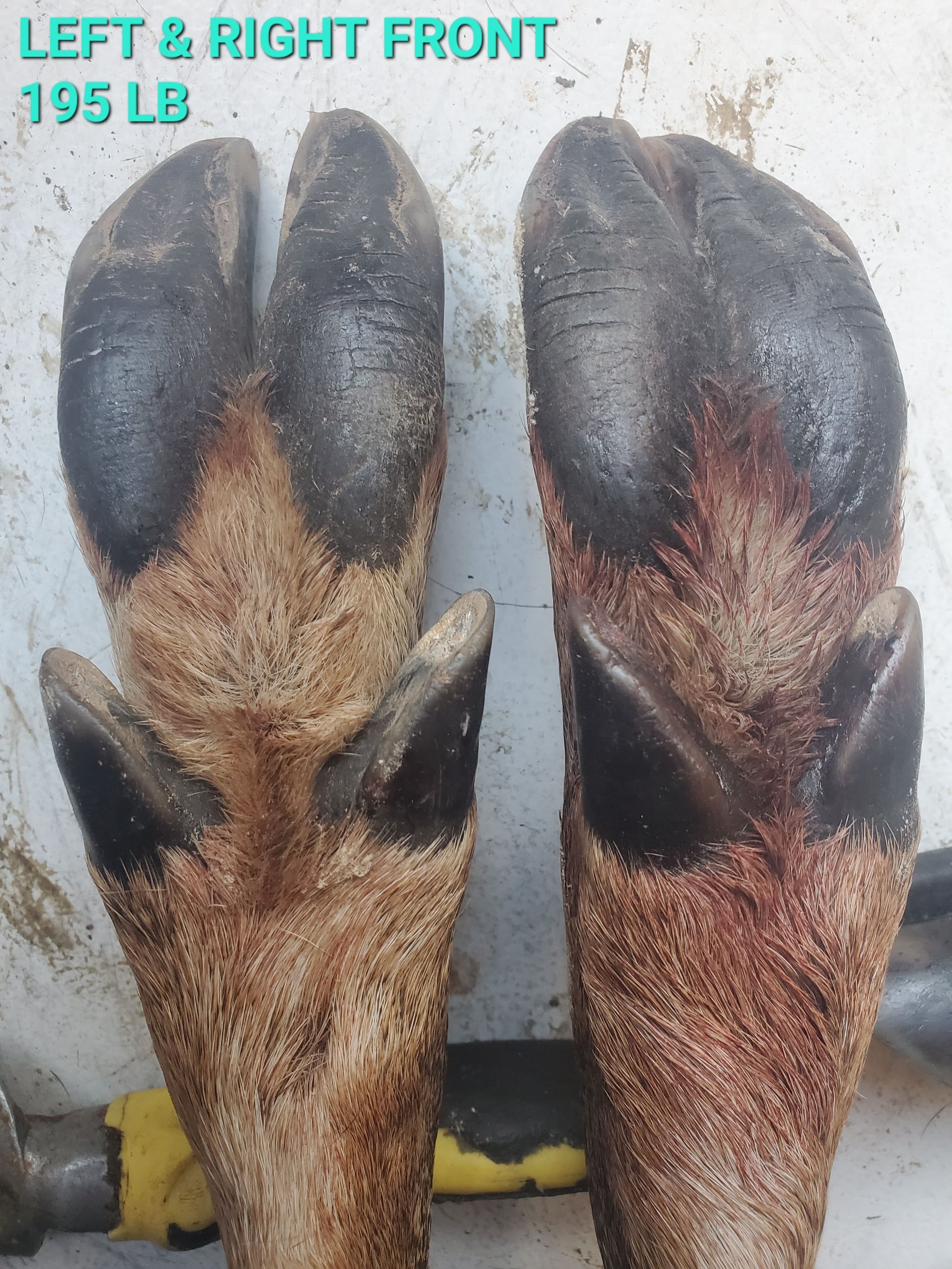
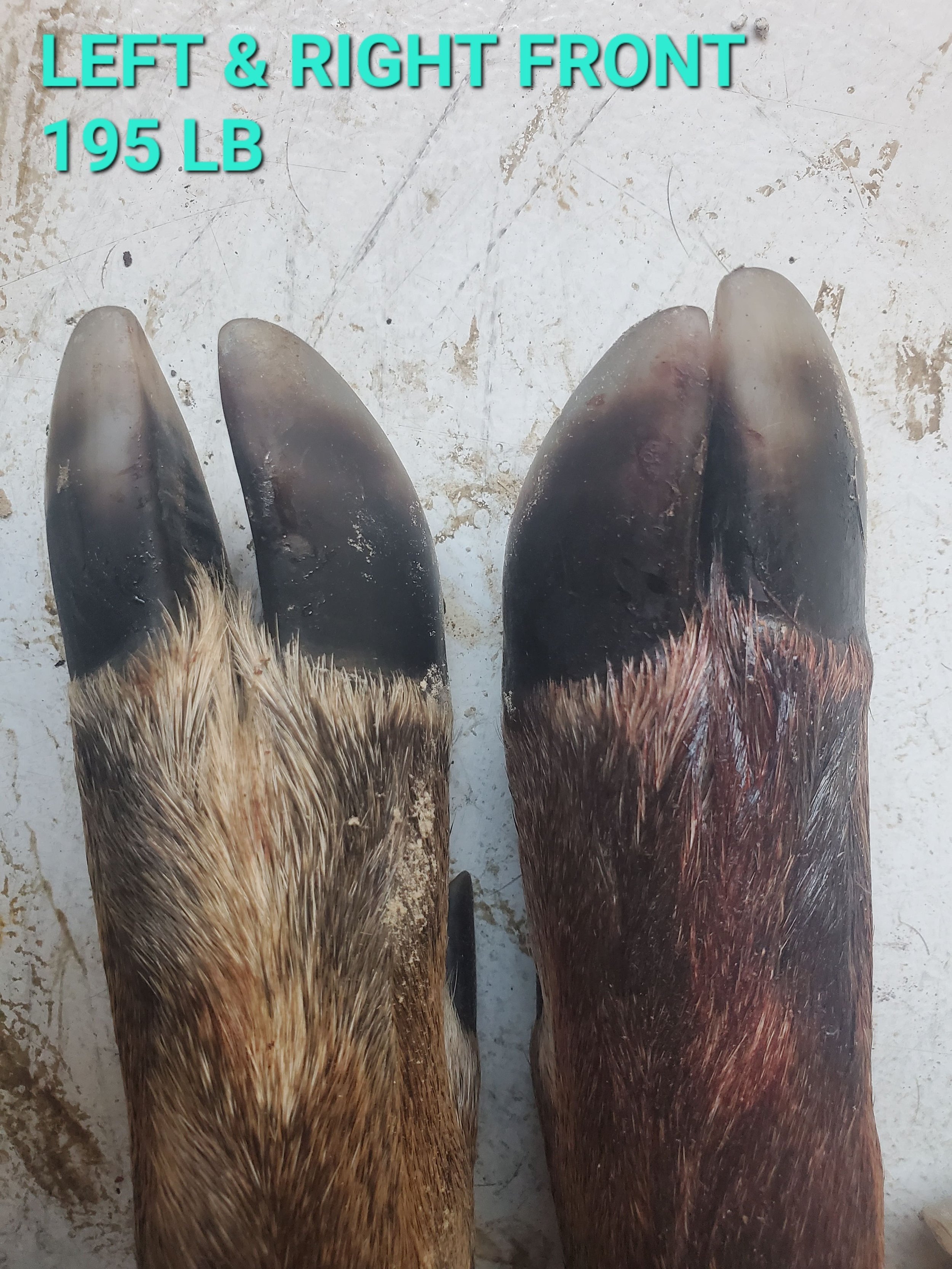
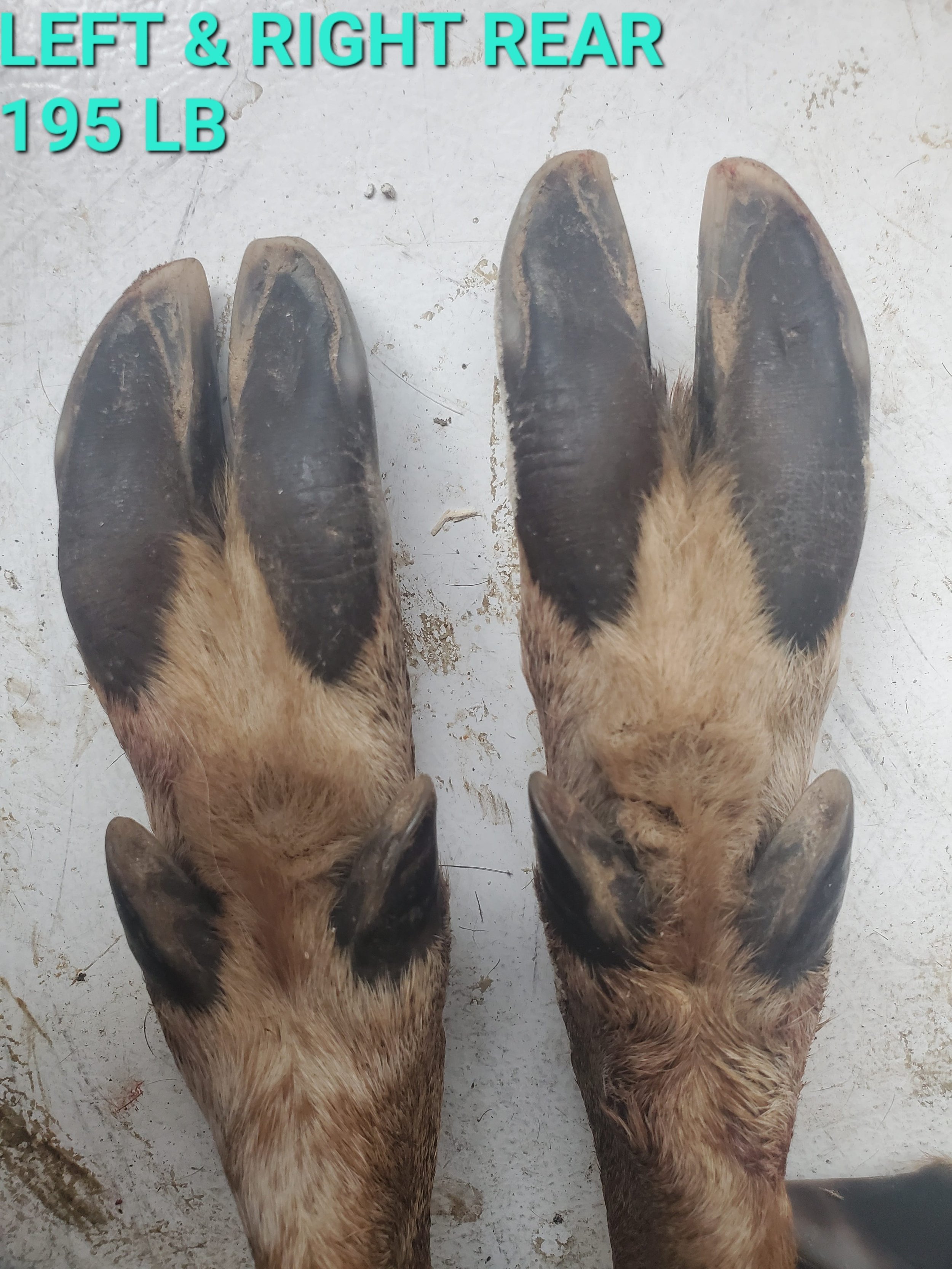
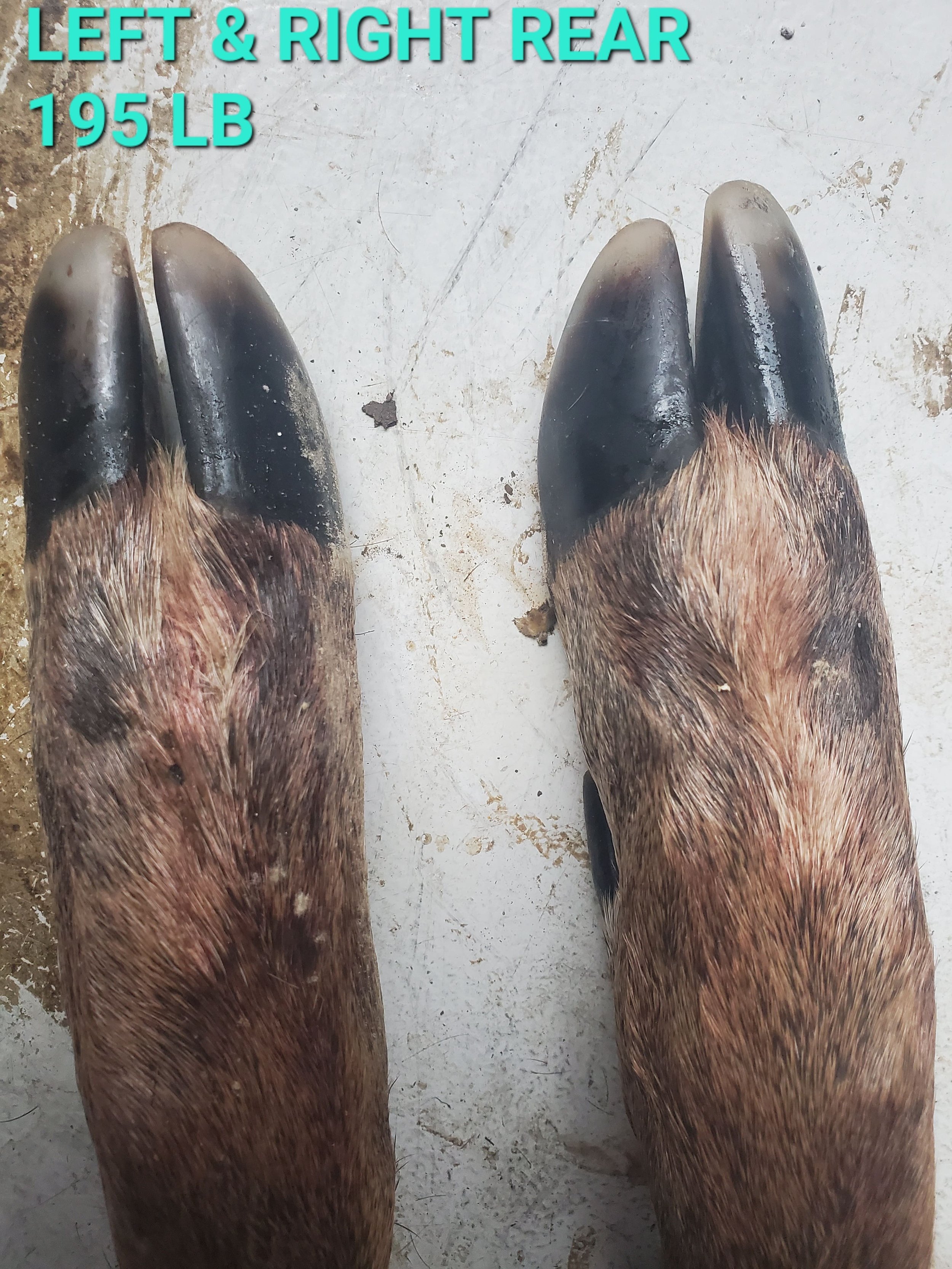
On our Slack channel Alastair later posted some photos of his work letting us know his neighbour had kindly marked the feet as fronts and rears/lefts and rights and which individual deer they came from. He wrote “I wanted to look at the three questions shown on the first photo relating to the dewclaws and the lengths of the two parts of the hoof. This information can be used to help understand which foot a particular track was made by.”
His three questions are very similar, or the same as what I am asking above. Which dewclaws are furthest from the hoof (fronts or rears)? Which dewclaws are most angled away from hoof cleave (the space between the toes)? And finally, which part of the hoof is the longest, the inside or outside? Of course they are phrased differently but I believe we’re after the same answers.
Alastairs findings agree with the first findings mentioned above, that the dewclaws sit further back on the hind feet, and that they are closer to the hooves on the front feet.
To back this up a third time, Mark Elbroch’s 2nd edition of Mammal Tracks and Sign states that “the dewclaws are higher on the hind legs than the fronts” in the entry on Mule Deer (Odocoileus hemionus) and Black-tailed Deer (Odocoileus hemionus columbianus). It is hard to differentiate between these two species and the White-tails by reading their tracks alone as they are all very similar. I will then assume, in light of our own research and this statement, that this also applies to the White-tailed Deer.
1) Can you tell front or hind (or rear as later described) foot in a track based on the location of the dewclaws? Yes. Dewclaws are set back further on the hinds, and closer on the fronts. “Back is back.”
According to Alastair’s study, the dewclaws on the front feet appear to be set more laterally than the rears. This runs counter to what I am seeing in the image taken and shared by Alexis, and this I love. I really appreciate when folks come up with different answers to the same question because it often means the answer isn’t always the same! Bodies can be different across an individual species. We see it with Humans (Homo sapiens) all the time! When it comes to my books, there is no mention of the lateral/medial position of the dewclaws to differentiate between fronts and rears, but Elbroch does write that when the dewclaws on the front feet register “they create oval impressions perpendicular to the cleaves, whereas when the dewclaws on the hind feet register, they create oval impressions in line with the cleaves.” I think inferences can be made from this that would agree with Alastair’s study, but I am not sure if it would hold up. I would need to hold a deer foot and feel the flexion and try to stamp tracks in a sandpit or snow to see what happens, or better yet, watch a very slow motion close up of the toes to watch a deer foot moving as they would on their own. So…
2) Do front or hind dewclaws reside in the same position on the foot or are they more laterally located on the leg depending on which leg it is we are examining? Dewclaws do not appear to have consistent positions based on front or hind feet.
As for the third question, can you tell left or right foot from the length of the toes, or as Alastair more clearly phrased it, which part of the hoof is the longest, the inside or outside? According to Alastair’s study, this errs towards the outside toes, but this isn’t always the case. Of 12 legs he examined, 9 of the legs demonstrated that the outside toe was longer, while the inside toe was longer for two legs, and on one left foot, the toe lengths were even. To corroborate this, in Mammal Tracks and Sign (again, 2nd edition) Elbroch notes that “toe 3 is often slightly smaller than toe 4, but not always” for both the fronts and hinds.
The results of Alastair’s study, and Elbroch’s notes are great to read about for this question because it agrees with my own ongoing study. Here is a short video I made of two incidents of finding rear legs of deer and comparing the toe length to see if the outside toe is larger, and then confirming the position of the leg to the body by looking at the ball socket which would have articulated with the pelvis.
3) Can you tell left or right foot from the length of the toes? Most of the time the outside toe, toe 4, is longer.
The anatomy and morphology of animals reveal so much of the natural history of the animal, from the skull to the toes, we can see their lives written in their bodies. By taking the time to better understand other animal bodies we can come to understand more from their trails as we track them. We can come to know the animal better both physically as well as ethologically, and to know someone better helps create stronger relationships, stronger bonds of connection. These stronger bonds hopefully turn into more care and consideration of the lives of others. I have found over and over in my life that when I am in better relationship with someone I want to do more to honour them and find it much harder to disregard their feelings or ways of being in the world. They are no longer a stranger but instead an acquaintance, a neighbour, kith, and I am motivated to come with respect, consideration and care.
Big thanks to the deer, to Alexis and Alastair for helping to teach me more.


